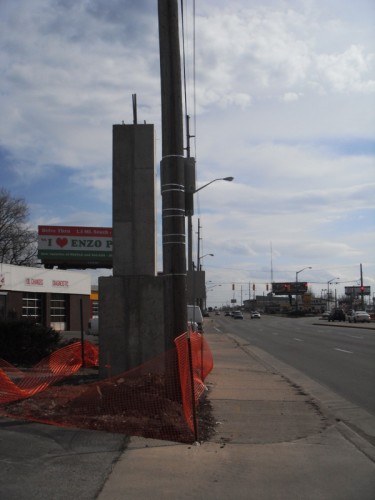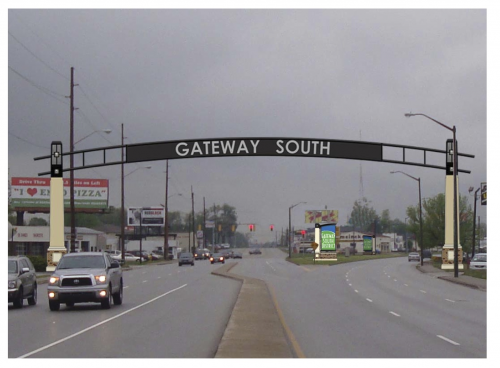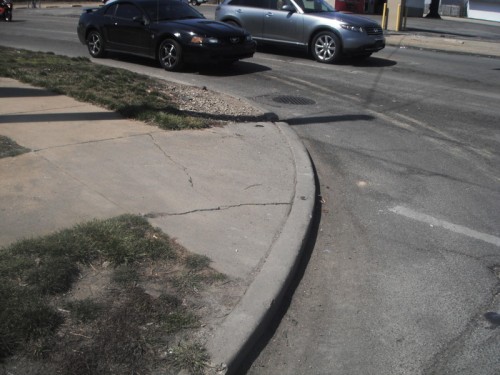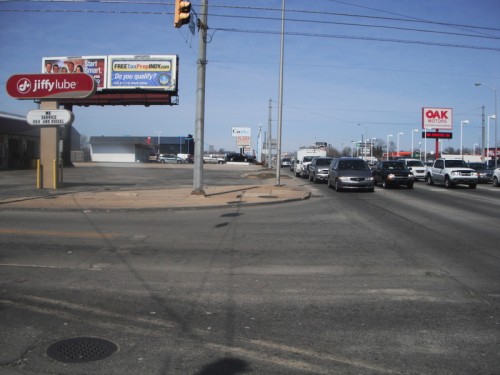Most people who have lived in Indy for at least a few years know that the south side of town is the least densely populated and, for the most part, the least developed of the four. Two of the three southside townships—Decatur and Franklin—still claim huge stretches of land that are essentially rural farms, and the I-465 beltway does not extend nearly as far southward from downtown as it does in the other cardinal directions.
However, the reputation that the south side has of being almost rural seems completely unfounded, when one considers some of the densely populated areas immediately south of downtown, including neighborhoods such as Babe Denny, Bates-Hendricks, Sacred Heart, South Village, and Garfield Park. The high level of development continues into Perry Township, home of such communities as Homecroft and Southport and the most densely populated of the three southside townships.  By many metrics, though, the south side of town still lacks a key defining visual element to distinguish it. In addition, the primary commercial corridors of Madison Avenue and U.S. 31 (East Street) have suffered from some of the typical outward migration of businesses toward the southern reaches of Indianapolis and the suburb of Greenwood. An area called the Miracle Mile, centered around where Madison Avenue splits to form U.S. 31 and southbound Madison Avenue, was thriving with shopping and dining opportunities in the 1950s. Today, it’s spotty, offering some still-successful businesses but many shuttered storefronts, vacant lots, or used car dealerships broadly indicative of depressed land values, as I indicated on a previous blog article.
While many business owners in the area have long been aware that it needed a facelift, the tornado of May 30, 2004 proved the catalyst. Ripping through a broad stretch of the city, including its most historic neighborhood (Homecroft), the F2 tornado damaged a number of businesses across the south side in general and the Miracle Mile in particular. Over the next few years, the greater community around the East Street and Madison Avenue corridors organize to form the Gateway Business Alliance. Doing business as the Gateway Community Alliance (GCA), the organization’s primary goals include economic development, expanding educational opportunities and the redevelopment of housing in the area. Since the tornado, the GCA has witnessed more than $30 million in private investment flow into the area, despite contending with one of the longest and severest recessions in recent history.
Even with these achievements, the GCA’s profile has been relatively low. However, that is about to change with the completion of an important visual element to improve the streetscape:
These big cement columns flanking the road don’t look like much at the moment, but soon they will materialize as the Gateway Arch, a primary feature in the Gateway South Initiative.
Jeff Cardwell, Founder & President of the Gateway Community Alliance (and a City-County Councilmember until recently), was able to provide me with some renderings of the arch should look like when complete. Here’s a view southward, right where Madison Avenue and U.S. 31 diverge:
Notice the small sign in the background, in the grassy area formed by the Y-shape at the point of divergence. This northward view along U.S. 31 better demonstrates the placement of these two signs—what the Initiative is calling “community windowsâ€.
After multiple years in design by HNTB, this arch broke ground several weeks ago, with an anticipated completion date in time for this year’s Miracle Mile Parade on August 31. The two columns on either side of Madison Avenue will feature pedestals of brick and split face stone, supporting masts made of cast stone. The black arch itself will be made of brushed and polished steel. Clearly it intends to serve as a landmark, a prominent visual cue in an area with little other evidence of unity among the existing structures. The arch is appropriately scaled to attract the eye of motorists passing by, while the more modest community windows are better suited for pedestrians.
The development of the District Gateway includes far more than just these new fabrications, however. The arch and community windows help to kick off a broader master plan for the area to improve its overall attractiveness. The site plan around the arch reveals the level of care being put into the landscaping for the Madison/US 31 divergence point:
These plans merely capture Phase One of a project with considerable geographic scope and a greater time horizon. The overall focus area includes Raymond Street to the North, Thompson Road to the South, Keystone Avenue to the East, and Bluff Road to the West—in short, the most populous expanse of Indy’s south side within the I-465 beltway.
Other, subtler aspects of the initiative are visible in various fits and starts. Among the most visible are the significant improvements along the Hanna Avenue corridor east of Shelby Street, the hub of activity for the University of Indianapolis. UIndy primarily sits on the northern side of Hanna Avenue (the right side of the street in the photos below), but a few old buildings rest to the south, and most of the university’s expansion is taking place on that side, integrated with old houses in the University Heights neighborhood.
During school passing periods, the density of pedestrians crossing Hanna is moderately heavy, and the improvements have provided copious crosswalks, landscaped medians, specialty lighting, audible flashing signals at important intersections (such as Otterbein Avenue), and a replacement of the ugly cable-suspended stop lights with metal masts and stanchions.  Anybody familiar with the campus beforehand would recognize that the aggregate results have helped to calm traffic along Hanna Avenue so that the thoroughfare does not split the campus in half as dramatically as it did before. In addition, overhead power lines have been buried through the entire width of Hanna that passes through campus.
Beyond the UIndy campus, however, the pedestrian streetscape is less impressive.
West of the campus along Hanna, the sidewalk suffers the usual double-barreled Indy shortcoming: installation of the pavement right along the curb (no tree lawn to shield pedestrians from speeding traffic), and the quintessential utility poles protruding from the sidewalk.
And, while the intersection with Shelby Street clearly has undergone upgrades, west of Shelby is less impressive. At the intersection with Madison Avenue, sidewalks are already inconsistent:
And between Madison and U.S. 31, Hanna only received the sidewalk treatment on the south side of the street, a frustratingly common DPW tactic that I featured at a recent improvement along South Emerson Avenue.
Notice that the north side of Hanna includes a bus stop, but potential passengers have to stand in the grass—not an easy situation for a person using a wheelchair or stroller, but a common configuration throughout the south side of Indy. Meanwhile, at the intersection of Hanna and U.S. 31, the crosswalk is incomplete: no signals, and no curb cut on the southwest corner, making it impossible for a wheelchair to get from the street to the sidewalk.
Meanwhile, the opposite side of the street lacks crosswalk features altogether.
Apparently work has also begun on the streetscape along Shelby Street. One of the most significant improvements, largely supported by the GCA, was the installation of bike lanes along Shelby Street, connecting University of Indianapolis up to Garfield Park and then again into Fountain Square. The photo below, south of the Shelby and Sumner Avenue intersection, reveals some new drainage upgrades that are visible at the horizon:
The Gateway South initiative is obviously an incremental process. Frankly, I think it has been a wise decision to begin with the most visually stimulating element: the formidable arch spanning across six lanes of traffic. It demonstrates unequivocally the sincerity GCA’s plan and its ability to implement the most ambitious element. However, I have followed the evolution of the design of this project over the years, and I recall one of the earlier master plans showing clearer articulation of the installation of sidewalks, crosswalks, and lighting, most of which are absent in the more recent iterations. Mr. Cardwell has assured me that those will take place in later phases.
My hope for this expansive streetscape improvement plan is that it will emphasize quality and comprehensiveness over speediness of implementation. If it takes twice as long to raise the funds to install sidewalks on both sides of Madison Avenue, U.S. 31, Shelby Street, as well as the east-west collector roads (Hannah, Troy, Sumner), it would be worth it in this area with a heavy concentration of businesses and residences, often immediately next to one another. The density of activity more than justifies sidewalks that comply with the city’s Complete Streets bill that passed last year. (A significantly less dense area in Decatur or Franklin Township, for example, may only warrant a sidewalk on one side of the road.) Most likely, much of the Gateway South’s focus area developed at a time before it was incorporated into the city; prior to 1970’s Unigov, Troy Avenue was the southern boundary. As a result, the area evolved with less rigid zoning regulations and considerably less advanced infrastructural investment that it otherwise might have enjoyed. The catch-up process may prove slow and costly, but the integration of key visual landmarks with a vastly improved pedestrian environment should ensure a smart blend of aesthetics with unquestioned utility.

















Glad to see potentially productive projects heading to the south side. I know many within my circles refer to this south side as “the dead side.” This are needs a sense of character!
The engineer used the radius of the arch for the curb turning radii. Can’t wait to walk this area!!
One of the biggest issues for this area and the southside in general, is the lack of bike/ped thruway. Northside has the Monon and the eastside has the Pennsy. I’m assuming that getting out to the westside is similarly difficult to the southside.
I realize that Shelby/Madison has bike infrastructure, but it consists of sharrows and unprotected lanes. It will be a cold day in hell when I take my kids in a trailer down Madison much less let them ride their own bikes.
I suppose the Gateway area could just put bridges over the arterials from parking lot to parking lot. Obviously, I’m being sarcastic but until the southside can reduce car dependence, it will continue to struggle. This window dressing doesn’t do a whole lot, in my opinion.
One frequently-repeated error is the placement of those buttons that request the ped crosswalk light. Perhaps the worst of these I have found is the SE corner of Raymond and Meridian. A wheelchair-bound person cannot reach the buttons because they are positioned far off the new sidewalk – which has a raised curb between the sidewalk and the pole that supports the traffic signals and is where the buttons are.
In Chicago I’ve heard them called placebo buttons because they are literally not connected to anything and only serve to calm your nerves and give you a false sense of hope that you control the light.
If only it were true that we had “placebo buttons” in Indy, that would mean that pedestrians wouldn’t have to wait through a full signal cycle to get a walk signal. The surest sign of an intersection not being pedestrian friendly is the requirement to seek out and push a button in order to safely cross the street. I cringe every time I discover that another intersection has been converted to require push button activation. Unfortunately it even happens downtown where ped traffic is fairly frequent.
The crossing times at Ohio & Alabama, on the Cultural Trail, were recently reduced so a minimal amount of “walk” time is given and then a solid “don’t walk” is displayed for about the last fifteen seconds of green light. Ridiculous! But, unfortunately, all too common in this city that is decades behind in street design and alternative transportation accommodation.
Actually, Alabama gets the left turn for about 10 seconds in the light cycle during which the Trail has a don’t walk. Are you sure that isn’t the dead time you refer to? It isn’t all that clear why you can’t walk as a ped if no one is turning left and you are walking northbound, but the reason is the left turn signal.
No, I’m not referring to the left turn green arrow time. The ped signal was actually going to “Don’t Walk”, or a solid hand actually, for about 10 seconds before the green arrow even came on. I reported it to the MAC, so perhaps they’ve been out to address it.
It seems to be typical of a mindset that the pedestrian signal should only give the minimal amount of time to cross the street if a pedestrian happens to push the activation button and be there right at the beginning of the “walk” signal. The signal will then go to the solid hand (“Don’t Walk”) and the light will remain green for however long the green phase is scheduled to last. I’ve seen this at so many intersections. This eliminates the possibility for other pedestrians, who might approach the intersection five to ten seconds after the green light/walk signal begin, to be able to safely cross with enough time on the pedestrian signal. I find it very frustrating when pedestrians are forced unnecessarily to wait through an entire additional signal cycle in order to cross a street.
I think this has an impact on pedestrian convenience and effects whether and how much people choose to walk in particular areas. Instead of making it less convenient for pedestrians to cross streets, we should be doing the opposite, if we want to increase public health and reduce dependence on automobiles.
So I was intrigued by your comment and was in this area yesterday, so I checked it out. It ended up being so much worst than you said. I timed it and there is 30 seconds between the end of the ped/bike walk signal and the left turn arrow! Unbelievable. I am going to be calling the mayor’s action center to get this fixed. It HAS to be a mistake.
I only checked Ohio and Alabama but I’ll check the others tomorrow before I call.
Two things:
1) Submitted a MAC report.
2) I checked New York, Ohio, Market, and Washington. Market and Washington were fine. Ohio was about 30 seconds of dead crossing time. New York was about 20 seconds of dead crossing time. I felt like the green light on Alabama was a lot longer than I remember it so I’m thinking they lengthened the light, but didn’t adjust the ped signal.
We’ll see and I’ll let you know what I find out.
It’s so nice to encounter someone who understands the importance of this issue and who actually has the passion about it to go out and observe it. I counted the same 30 seconds of dead time at Ohio & Alabama myself last night.
Do please let us know if you get any response from the MAC, and I’ll try to keep an eye on it as well.
Alright, the RequestIndy thing submitted to the MAC shows as closed. No details were given as to the response, so I have no idea if it is fixed or only put on the agenda to be fixed later or completely ignored.
One little tidbit… the person who does all, and I mean ALL, the signal timing for the city has left. Its a shame they put that all on just 1 person.
Drove through the intersection of Ohio & Alabama this evening and the ped signals have not been corrected yet. In a City of ~800,000, I certainly hope there is more than one person authorized to make decisions on adjusting signals.
I talked to our Mayor’s Neighborhood Liaison about the lights and she said if it isn’t corrected in about three weeks to call her. That was about two weeks ago. I’ll get in contact with her next week.
One other comment. I rode the 31 bus to Greenwood back in early January after a major snowfall. I don’t know if there is some unbreakable protocol, but the bus driver dropped people (including an elderly man and a woman with a child) off in the snow bank where the bus stop sign is instead of the plowed driveway 15 feet further down the road.
Thanks as always for all the comments. Ahow628, you raise some excellent points, though I’d also call this an example not letting the perfect be the enemy of the good. I have routinely ridden the lanes on Madison/Shelby and, while I may be more desensitized to this than most, have never felt unsafe with the presence of the lanes. The Shelby Street segment with sharrows is one of the few examples I’ve seen in American cities where the sharrows are used appropriately and correctly. And I just don’t see any great likelihood of ever having a protected lane for such a long and little-used stretch. At this point, the approximately one mile of Shelby that’s protected is still a relative novelty in American cities. I don’t expect the south side ever to be anything less than auto dependent in my lifetime, so, adjusting to a more realistic outcome, incremental changes such as these can provide more than enough appeasement.
John Howard, thanks for raising that excellent point regarding the ped crosswalk buttons. This is a common error in design seen throughout the country.
After re-reading my bike lane comments, I would like to clarify that I do appreciate the lanes on Madison for myself. My parents live in old town Greenwood and I live Fletcher Place, so it is nice for me to ride down by myself.
What I was getting at was that my 4 year olds will not be utilizing them to get to their grandparents for many, many years and I would doubt my wife (who just learned to ride) would ever feel comfortable. If my parents lived in Broad Ripple and the Monon was an option, I have a feeling we would mostly ride to visit them.
It is all but an impossibility, but a nice greenway trail down to Greenwood would be a dream come true.
Impossibility? Couldn’t one be built in/along the old rail corridor that is occasionally talked about for potential rapid transit?
At one of the Indy Connect meetings, someone asked about that and it sounded like CSX was planning on expanding freight service on that route and there is not enough ROW for an additional set of rails, so basically, that route is going to be off limits for transit.
If it is out of the picture for transit, I can’t imagine it being available for a greenway.
That being said, I agree that would be a nice place for a greenway to Greenwood.
You may certainly be right, but I would think that a trail could be squeezed into a smaller space than a rapid transit line (presuming two tracks). Perhaps, it still could be added next to the tracks, separate by a fence, the same way the lower part of the Monon is separated from a set of tracks, albeit inactive ones. And if need be, perhaps the City could acquire 15-20 feet from the adjacent properties, but perhaps that would get too expensive. Just a thought.
Thanks again for the observations, especially Idyllic’s recognition of how often the “placebo buttons” are both inaccessible to persons in wheel chairs and how they still create a system that overwhelmingly favors vehicular traffic. I attended a conference in Kentucky last year on pedestrian crossing/signalization, and I think there’s an increasing awareness of the need to address each of these problems (particularly the placement of the buttons so people can reach them). By contrast, there doesn’t seem to be anyone questioning whether we actually need buttons to begin with. The buttons were relatively uncommon except for a few East Coast cities 10-15 years ago; now it seems like the rest of the country is adapting them, often due to legal mandates.
Ahow, one geographically small but potentially serious means of improving safety on bike lanes would be to offer warning signs at railroad crossings, particularly when the crossing isn’t perpendicular. An example of this is on Shelby Street just south of Hanna Ave (going southbound) where the bike lane meets an old interurban track at about a 10 or 15 degree angle. If you’re not thinking about it or if it’s dark outside, it’s pretty easy to wipe out like I did: get your tire caught in the groove from the old track and the your bike wretches you to the side. Warnings like this may be more useful than the sharrows on other sections of Shelby, which are still good because they’re among the few correct uses of sharrows that I’ve seen anywhere.
Agree on the train track crossings. At the Mayor’s polar bear ride two years ago, an office who was riding as an escort wiped out on the tracks north of 10th St on White River Pkwy and shattered his arm and was out of commission for about 3 months. Goes to show that even if you know they are there, they are dangerous. Much worse if you don’t know they are there or don’t have rail crossing experience.
Contra thought re ped-crossing buttons: there are lots of places with sensor-activated vehicle signals, too.
At such intersections, lights ride through their periodic cycle but if no vehicle is detected on the sensor loop, a cycle might be skipped in favor of the street/road with preference.
There is a “green” reason to do this: activated lights reduce idling vehicle emissions on the main thoroughfare. If every light went through a full cycle (whether needed or not), there would be vehicles stopping, idling, and re-starting needlessly.
I can see the need for automatic pedestrian cycles during most daytime hours and weekend evenings downtown, and in other pedestrian zones (IRV, BR, E10, urban school zones, etc.). But I think there should be some judgment applied as to place, need, and time of day.
Why not a sensor that automatically identifies approaching pedestrians and presents them with a “walk” signal? Although it probably needs to be a little more sophisticated than a simple metal detector for vehicles, I attended a workshop several years ago where I was told that those were already starting to be implemented.
Can you imagine a world where a driver would be required to stop at an intersection, get out of the car, and walk several steps to push a button in order to get a green light? But really, why should our streets be more difficult and less convenient for pedestrians than for drivers?